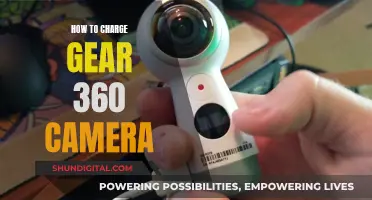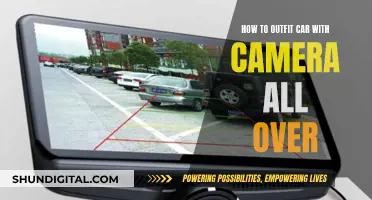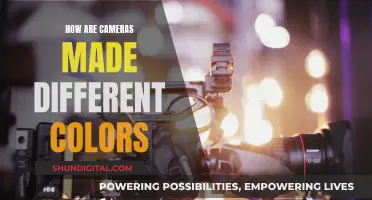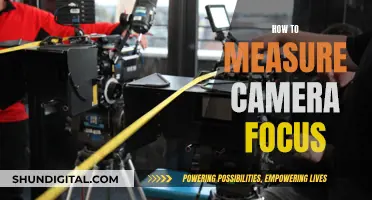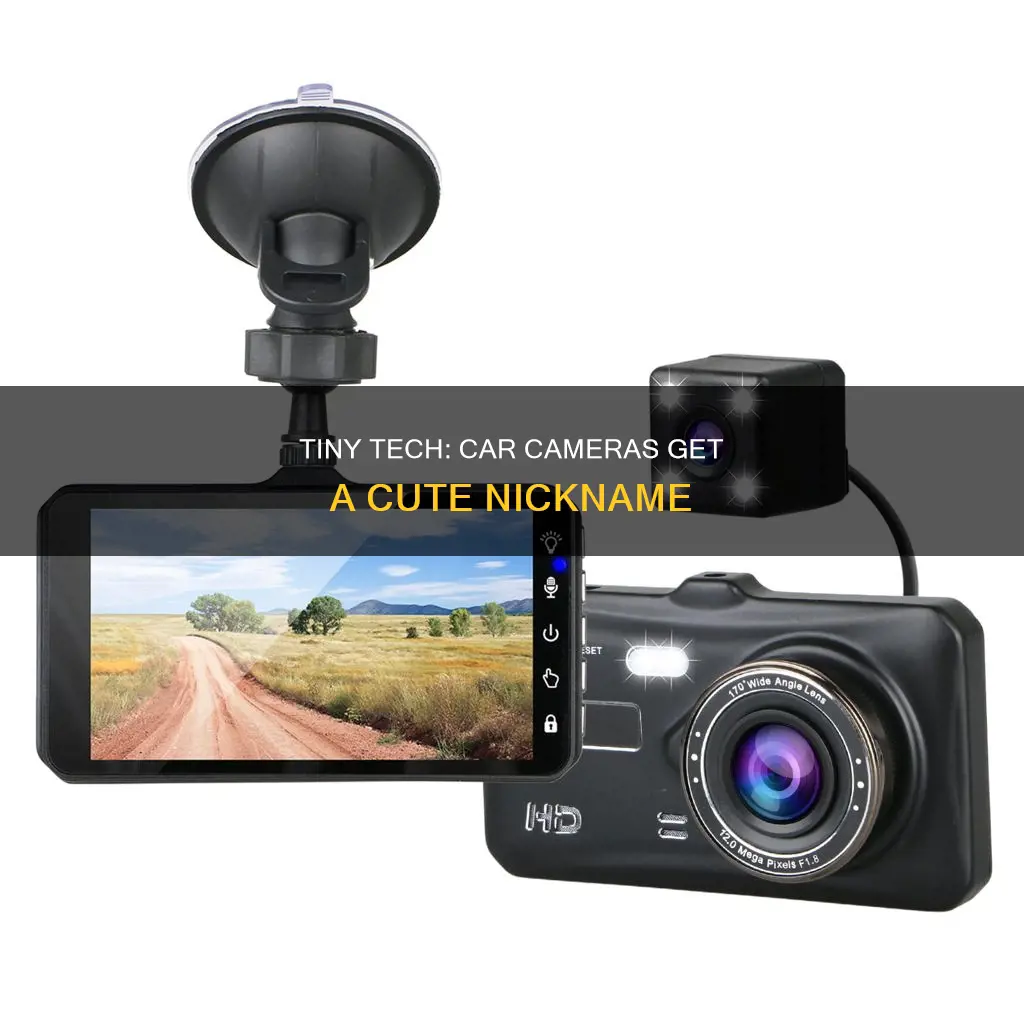
A small camera in a car is called a dashcam, and it's a convenient and life-saving tool. It records the view through a vehicle's front windscreen and sometimes the rear or other windows. Dashcams are usually mounted on the dashboard or hung from the windshield, and they turn on when the car is powered on. They can also be hardwired to the car's fuse box to record when the car is off. The footage captured by dashcams can be used as evidence in the event of accidents, insurance fraud, or other unexpected incidents.
| Characteristics | Values |
|---|---|
| Name | Dashboard camera, dashcam, car digital video recorder (car DVR), driving recorder, or event data recorder (EDR) |
| Purpose | Record incidents, accidents, insurance issues, traffic tickets, theft |
| Placement | Dashboard or windshield |
| Power source | Car battery, USB port, cigarette plug, hardwired into the vehicle's fuse box |
| Storage | SD card, micro SD card, cloud storage |
| Features | Wi-Fi, Bluetooth, 4G, GPS, night vision, loop recording, motion detection, parking surveillance, advanced driver assistance system (ADAS) |
What You'll Learn
- Dash cams are also known as driving recorders or event data recorders (EDRs)
- They are plugged into a car via a USB port or cigarette plug
- They can be hardwired into a car's fuse box to record when parked
- They can be used to prevent theft, clear up insurance issues, and fight traffic tickets
- They are inexpensive to operate and have a low initial cost

Dash cams are also known as driving recorders or event data recorders (EDRs)
Dash cams, also known as driving recorders or event data recorders (EDRs), are small cameras that are usually mounted on the dashboard or the windscreen of a car. They are designed to record the view through the front windscreen and sometimes the rear or other windows. Dash cams can also be attached to the rear-view mirror or the top of the dashboard using a suction cup or adhesive tape.
Dash cams are a convenient and valuable tool, especially in the event of an accident or any other unexpected incident on the road. They are often used to help prevent theft, clear up insurance issues, and even fight traffic tickets. They can also be used to monitor the driving habits of someone else in the car, such as an inexperienced or older driver. Additionally, a dash cam can come in handy if you want to capture and share memorable moments or unusual events during your drive.
Dash cams are powered by the vehicle's electrical system, typically through a USB connection or a cigarette lighter socket. They record continuously onto a memory card, usually an SD or micro SD card, overwriting the oldest footage when the card is full. Most dash cams also have features like GPS tracking, Wi-Fi connectivity, and night vision mode, enhancing their functionality and making them a popular choice for many drivers.
With the increasing popularity of dash cams, some car manufacturers are now incorporating built-in camera systems, recognising the benefits they offer to drivers in terms of safety and security.
Mastering Camera Raw: Saving Adjustments Like a Pro
You may want to see also

They are plugged into a car via a USB port or cigarette plug
Dashboard cameras, or dashcams, are cameras that are either placed on your dashboard or attached to your windshield to record as you drive. They are plugged into your car via a USB port or cigarette plug, and they are powered by the car's battery. Dashcams are a great way to protect yourself in the event of an accident, clear up insurance issues, or even fight traffic tickets.
Dashcams are easy to set up and use. Once you turn on your car, the dashcam will also turn on. The camera will have a memory card input, usually an SD or micro SD card, to store the recording. You can then mount the dashcam to your dashboard or windshield and point the camera inside the car or ahead of you to monitor what is happening in front of your vehicle.
When the SD card is full, the dashcam will start erasing the oldest footage to make space for new recordings. This could be after 8 hours, or even up to 48 hours, depending on the amount of memory the card can hold. Most modern dashcams also come with Wi-Fi capability, allowing you to connect to an app on your smartphone to view your recent footage.
Dashcams are a better option than other video recording technologies as they are designed specifically for recording high-quality video while your vehicle is parked or in motion, and they can withstand extreme temperatures when mounted on your windshield. Additionally, dashcams can save videos automatically when a collision is detected, and they can be easily shared with insurance companies or the police after an incident.
If you are looking for added protection while driving, a dashcam is a great option. With video evidence, you can effectively fight driving charges, prevent theft, and keep your insurance rates low in the event of an accident.
Activating Macro Mode on Panasonic Cameras: A Step-by-Step Guide
You may want to see also

They can be hardwired into a car's fuse box to record when parked
A small camera that is placed in a car is commonly known as a dashcam. Dashcams can be hardwired into a car's fuse box to record when the car is parked. This is one of the most common installation methods to power on a dashcam when the vehicle is off, thus offering parking mode recording.
Hardwiring kits are available for dashcams and have become a popular option for new and experienced drivers. They provide power to the dashcam, prevent battery discharge, and allow the dashcam to capture important moments, whether on the road or parked. Hardwiring is also the cleanest install option.
To hardwire a dashcam, you will need to gather all the necessary tools and locate the fuse box. The fuse box is usually found under the steering wheel, but you can also refer to the user manual for detailed location information. Once you have located the fuse box, you will need to select an appropriate fuse to tap power from. It is recommended to choose a fuse with a current between 7.5A and 15A and to avoid fuses that control critical functions such as airbags, stability control programs, or the horn.
After selecting the fuse, you will need to connect the wires from the hardwiring kit to the fuse box. The red wire usually goes to a constant fuse, the yellow wire to the ACC/ignition-switched fuse, and the C-shaped wire is the ground wire. However, some kits may have a different wire configuration, so it is important to follow the labels attached to each cable. Once the wires are connected, you can test the dashcam by plugging it into the kit and starting the vehicle.
By hardwiring a dashcam to the fuse box, you can ensure that the dashcam has a reliable power source and can record footage even when the car is parked. This can be especially useful for capturing incidents such as hit-and-run accidents or parking lot collisions. Additionally, hardwiring a dashcam can free up the power outlet in the car for other uses, such as charging a phone or powering a GPS device.
Overall, hardwiring a dashcam to the fuse box is a straightforward process that can provide several benefits, including continuous power supply, prevention of battery discharge, and the ability to record when the car is parked.
Exploring Camera Tickets: Are They Still Used Today?
You may want to see also

They can be used to prevent theft, clear up insurance issues, and fight traffic tickets
Small cameras that are mounted on a car's dashboard or windscreen are called dashboard cameras, dashcams, car digital video recorders, driving recorders, or event data recorders. They can be used to prevent theft, clear up insurance issues, and fight traffic tickets.
Preventing Theft
Dashcams can be used as a form of surveillance to monitor a car even when it is parked and powered off. Some dashcams have motion detection features that can record when an approaching human or vehicle is detected. This can help save power and storage while also providing a reliable 24/7 parking surveillance.
Clearing Up Insurance Issues
Dashcams can be used to provide evidence in insurance claims. They can help prove who was at fault in an accident and protect drivers from being found partially at fault in an accident caused by another driver. They can also help fight insurance fraud, such as in the case of a staged accident intended to receive a fraudulent claims payout.
Fighting Traffic Tickets
Dashcams can be used to dispute traffic camera tickets by providing evidence that the driver was not at fault. For example, the footage could show that the driver was making a legal right turn on red when the camera took the photo. Dashcams can also be used to dispute speeding tickets by showing that the driver was speeding out of necessity to avoid harm.
Smart Strategies for Carrying Extra Camera Batteries
You may want to see also

They are inexpensive to operate and have a low initial cost
Dashboard cameras, dash cameras, or dashcams are cameras that are placed on your dashboard or windshield to record as you drive. They are inexpensive to operate and have a low initial cost.
Dashcams are plugged into your car via a USB port or a cigarette plug. They have a memory card input, usually an SD card or a micro SD card, to store the recording. Dashcams are very inexpensive to operate and have a low cost for initial purchases. For a camera with decent quality and memory, you should only expect to pay around $30 to $40 for a personal camera that you buy online or at the store.
Dashcams are often used to help prevent theft, clear up insurance issues, and even fight traffic tickets. They can also be used to monitor the driving habits of someone else in your car, such as an inexperienced or older driver.
Many dashcams include rechargeable batteries that are not needed when connected to a car battery wire or capacitors. Dashcams usually use class 10 or above MicroSDHC or MicroSDXC cards, usually 16 GB or higher, or internal memory to save videos.
Dashcams are widespread in Russia and the United Kingdom, where sales rocketed in 2015. They are also commonly used in China and the United States.
The Ultimate Guide to NVR Camera Battery Replacement
You may want to see also
Frequently asked questions
A small camera in a car is called a dashcam, short for dashboard camera.
A dashcam records video footage of the road ahead or behind a car. It can be used to capture incidents such as accidents, unexpected events, or traffic stops.
Dashcams are usually powered by the car's electrical system, either through a USB connection or direct wiring to the fuse box. They record continuously, overwriting old footage when the memory card is full.


